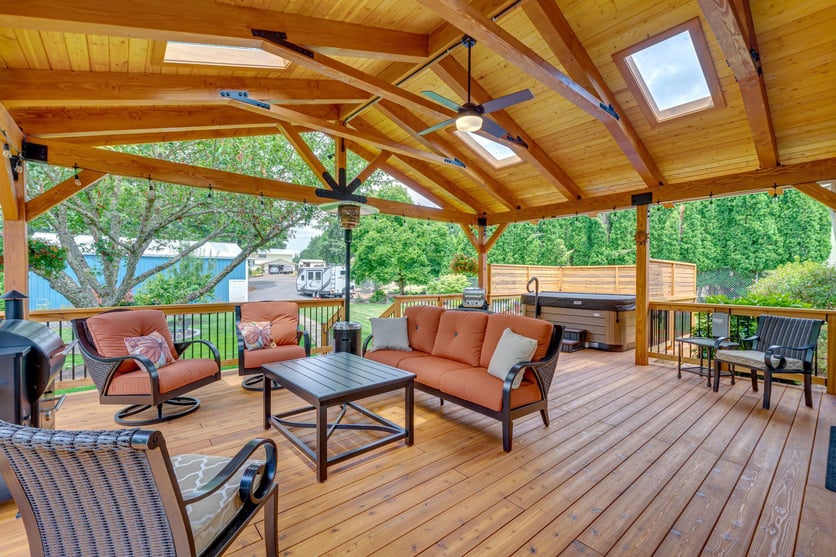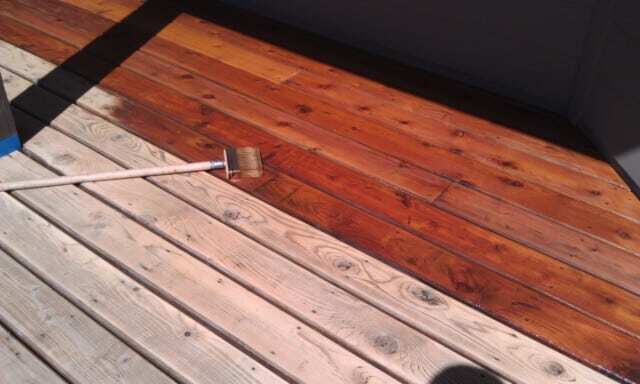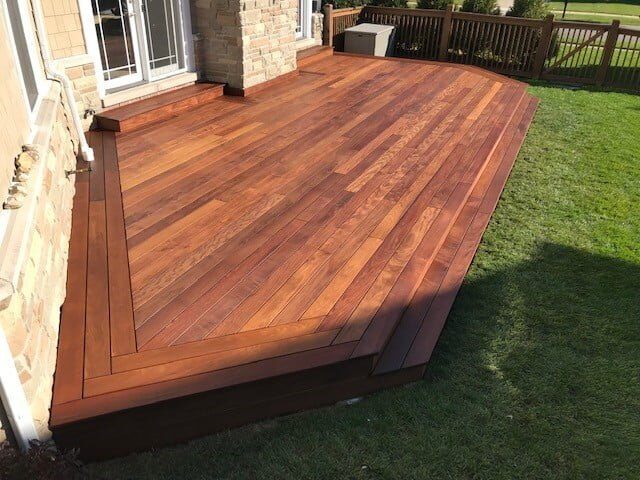Having a deck on your home can provide you with a great outdoor space to entertain guests, relax with family and friends, or simply enjoy nature. But when it comes to living in Oregon, many homeowners wonder if it’s worth it to build a deck on their home at all. In a region that experiences 150+ days of rain per year, you have to be strategic about how you design a deck if you want to be able to enjoy it.
Our team at Lamont Bros is no stranger to the challenges of outdoor living spaces. As a remodeling company that serves the Portland Metro Area, we’ve helped many Oregon homeowners build or repair their decks. Though it can be a challenge to build a deck that works great and lasts a lifetime, these challenges are easily solved with the help of a good designer.
This article will discuss the challenges of having a deck in Oregon and what you can do to build one that serves your needs. Once you finish reading, you’ll have a better understanding of construction best practices for building decks and can use that information to make informed decisions for your home. You can expect to read about:
- Challenges of having a deck in Oregon
- Wood timber decking
- Composite decking
- Hardwood decking
- Concrete or tile decking
What are the challenges of having a deck in Oregon?
For it to enhance your lifestyle, a deck must be designed with several challenges in mind. If a deck fails to adequately hold up to these common challenges, it could spell trouble for you and your home.
Cold, Wet Weather
It’s no secret that the Pacific Northwest gets a lot of rain. From October through March, 80% of days are rainy in Oregon. That’s not good news if you want to be able to use your deck during those months.
If it’s important to you to be able to use your deck year-round, there are a few solutions. The first is to build a porch roof that covers all or part of the deck. However, doing so will partially negate the open-air setting that makes a deck so inviting in the first place. Another option is to install a retractable awning over your deck. These products tend to be more effective against shade than rain and may look a bit tacky if not installed correctly.

Dryrot
Dryrot is a type of decay that occurs when moisture builds up in wood without proper ventilation. This creates an environment for certain types of fungi to thrive. As the fungus feeds on the wood, it breaks down the natural fibers, which weakens its structure and can eventually cause it to crumble. Due to the wet climate, dryrot is an especially serious problem for decks in Oregon.
In the case of a deck, preventing dryrot means making sure that water does not pool or collect at any of the major structural points. It’s also important to properly seal and maintain any wood that is exposed to the elements. The best way to accomplish this is to use pressure-treated framing members or deck flashing joist tape. Using non-wood building materials is also a good way to avoid rot.
Seismic Risks
Because most Oregon residents live within the Cascadia seismic zone, earthquakes can pose a risk to the structure of your decks. While most homes are built to withstand a seismic event, decks aren’t always subject to the same regulations and inspections. However, if a deck collapses during an earthquake, it could potentially cause injury or damage to the home.
When constructing a deck, it’s important to properly attach the support posts to a solid foundation and implement cross-bracing between them. It is also common to use lateral steel strapping on the joists to brace the deck against the home. These measures will prevent the deck from falling off its foundation or collapsing due to lateral movements caused by an earthquake.
What are the different types of decking materials?
There are a handful of different options when it comes to construction materials for your deck. Depending on your goals for the project and the amount of work you’re willing to do to maintain it, one may work better for you than the rest. Here are the most common decking materials.
Dimensional Lumber Deck
The most common type of decking material is natural wood. In Oregon, it’s common to see decks made from cedar, which is naturally water-resistant and holds up relatively well to the elements.
The major benefits of dimensional lumber decking are that it is inexpensive and easy to work with. Most of the materials you need to build a wooden deck can be purchased at the local lumber store. With the right tools, the wood can be easily cut, shaped, and installed.
However, wooden decks are notoriously difficult to maintain, as they require re-sealing at least once every two years to protect from rot and keep the deck looking fresh. This requires either a lot of work or a lot of money — most companies charge a few thousand dollars to re-seal a deck.
Pros:
- Natural wood look
- Easy to construct
- Lease expensive
Cons:
- Requires constant maintenance
- Prone to rot
- May turn gray with age

Composite Decking
If you’re looking for a long-lasting, low-maintenance decking material, composite products like those offered by Trex may be for you. Composite decking is a mixture of plastic polymer and wood fibers, making it very durable and unaffected by rot or water damage.
Composite decking also comes with its own set of challenges, as well. These types of decks cost more upfront to build because the material is more expensive and has different structural requirements. Whereas a wood deck can be built with joists spaced 24 inches on center, a composite deck must be built with joists 16 inches on center. This means more joists, which in turn means more material costs. However, once installed, a composite deck requires very little maintenance and does not need to be resealed regularly. As a result, composite decks can be less expensive in the long run.
During construction, composite decking also requires much finer attention to detail because the edges and spacing between boards are difficult and have very little room for error.
Pros:
- Extremely durable
- Requires very little maintenance
- Last 30+ years
Cons
- More expensive to build
- Difficult to install
- May look & feel like plastic

Hardwood Decking
Unlike traditional timber decking, which uses softwoods, hardwood decking is much less prone to water damage or rot. Mahogany and Brazilian ipe wood are among the most common types of hardwood materials used in decking. Hardwood decking tends to be much denser than other wood options, giving it a natural durability and resistance to the elements. It also looks great and adds a natural, luxurious feel to a home’s exterior.
The biggest downside to using hardwood decking is that it is much more expensive than a traditional lumber deck. For ipe wood, material costs can exceed 10 times that of a cedar deck. Due to its density, hardwood can also be difficult to install. Though less maintenance than a traditional wood deck, a hardwood deck will need to be cleaned and re-oiled every few years to preserve the lifespan of the wood.
Pros:
- High-end luxury appeal
- Very durable
- Natural material
Cons:
- Very expensive
- Requires some maintenance
- Difficult to install
Tile Deck
Tile is an exceptionally durable decking material when installed correctly. It’s common to find both this type of decking on flat-roof decks that sit overtop of living spaces. For the right type of home, it can be a very stylish material to use. Tile offers endless possibilities for colors, shapes, and lay patterns.
The important thing when using tile as decking material is to properly install the substrate on which it will sit. The substrate must be waterproof to prevent water intrusion, which can cause tile or concrete to crack and disintegrate over time. A wood substrate may also warp and bubble when exposed to water, which can cause cracks in the tiles above it. Many tile decks fail because of an improperly installed substrate, so make sure your builder does it right.
Pros:
- Extremely strong and durable
- Highly customizable design
- Good for flat roof decks
Cons
- Expensive installation
- Very heavy
- Requires waterproof substrate

Want to talk to a professional designer about your deck?
Now that you know more about the challenges of building a deck in Oregon and the different types of decking materials, continue your research. To learn more about exterior remodeling projects, check out our Additions Portfolio, which showcases many remodeling best practices when remodeling your home’s exterior.
Think your deck project might benefit from working with some of the top remodel designers in Oregon? If so, click the link below to schedule a free design meeting with a member of our team. We’ll help you turn your design dreams into a reality you can enjoy living in.



